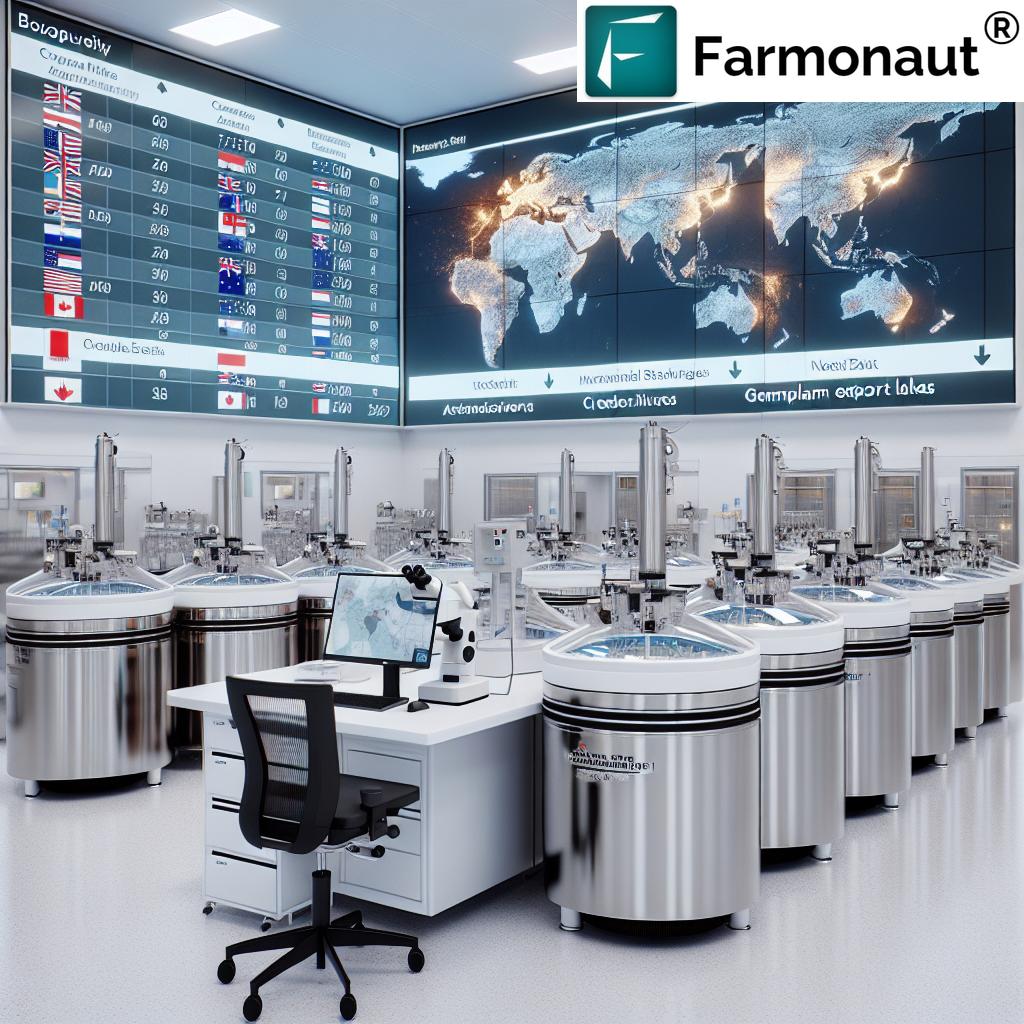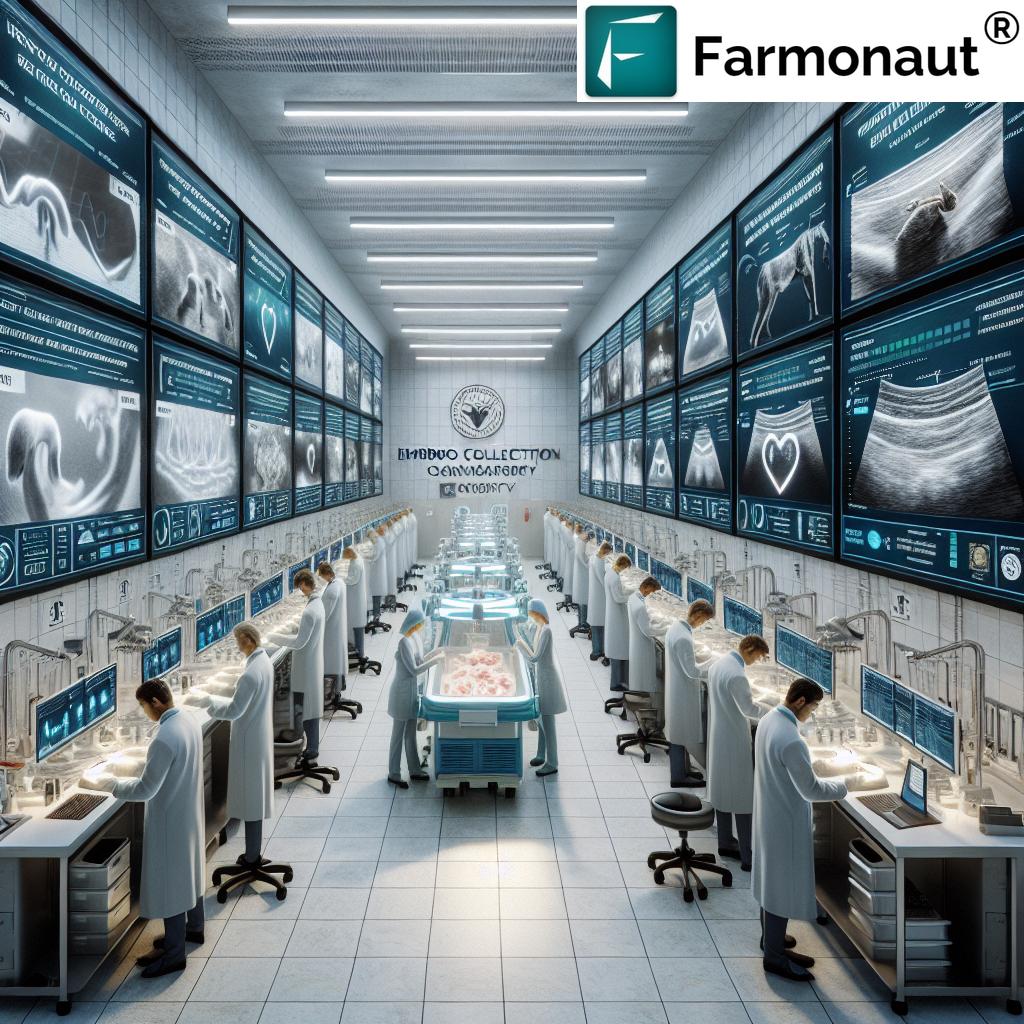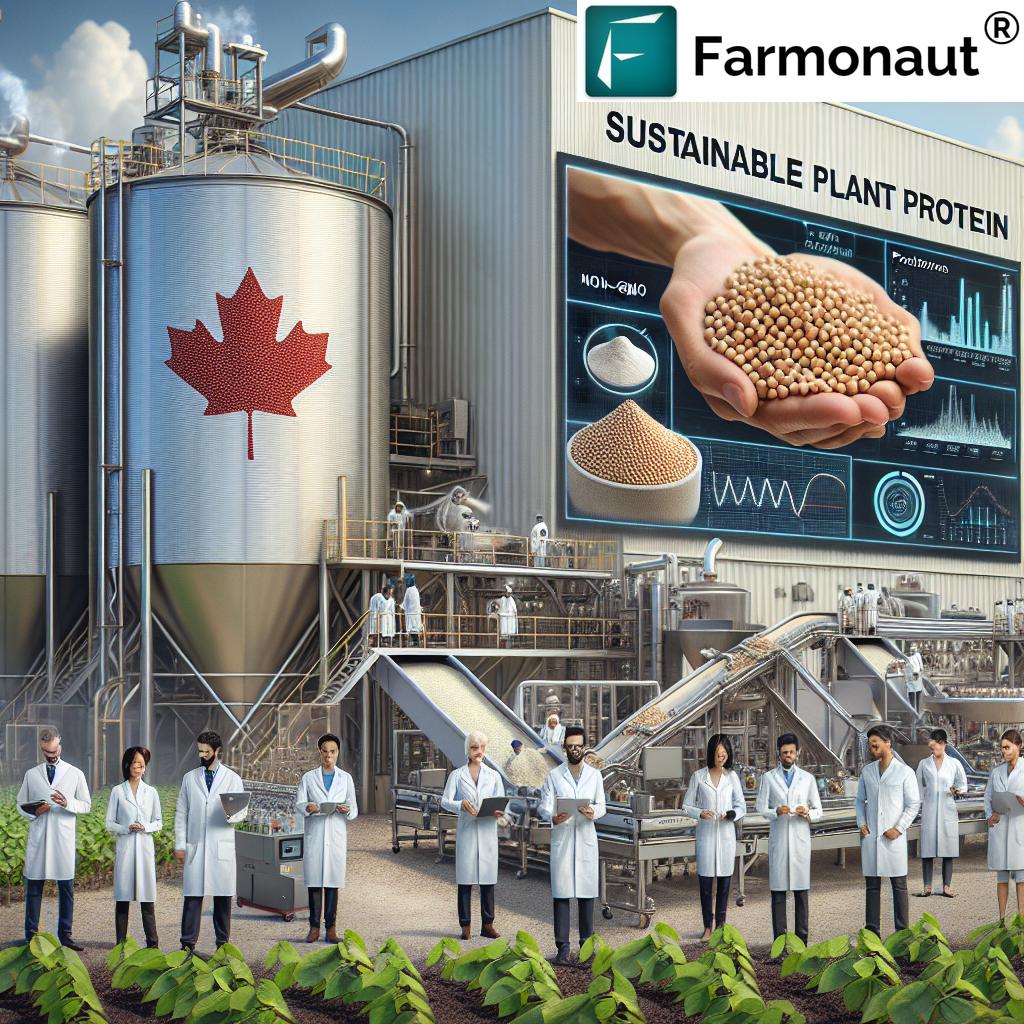Global Standards for Bovine Germplasm Export: Evaluating Biosecurity Measures in Australia, Canada, New Zealand, and the United States
“Four major countries – Australia, Canada, New Zealand, and the United States – are analyzed for OIE standards compliance in bovine germplasm export.”
In the ever-evolving landscape of international agriculture, the export of bovine germplasm plays a crucial role in genetic improvement and sustainable livestock production. As a team at Farmonaut, we recognize the importance of understanding and evaluating the global standards that govern this vital aspect of the agricultural industry. In this comprehensive analysis, we will delve into the intricate world of bovine semen collection and embryo export regulations, focusing on four major players in the global market: Australia, Canada, New Zealand, and the United States.
Our exploration will cover the stringent biosecurity measures, OIE standards compliance, and the complex interplay of veterinary services, animal health certification, and disease management protocols that form the backbone of the international bovine germplasm trade. By examining these aspects, we aim to provide valuable insights into the regulatory frameworks that ensure the quality and safety of bovine genetic material across borders.

As we embark on this in-depth analysis, it’s important to note that while Farmonaut specializes in advanced agricultural technology solutions, our focus here is on providing an objective assessment of the regulatory landscape. Our expertise in precision agriculture and data-driven insights allows us to appreciate the complexities involved in maintaining high standards in the bovine industry.
The Importance of Global Standards in Bovine Germplasm Export
Before we dive into the specifics of each country’s approach, let’s understand why global standards for bovine germplasm export are so critical:
- Genetic Improvement: Bovine semen and embryos from high-quality livestock can significantly enhance the genetic potential of herds worldwide.
- Disease Prevention: Strict biosecurity measures are essential to prevent the spread of animal diseases across international borders.
- Economic Impact: The international trade of bovine germplasm contributes significantly to the global agricultural economy.
- Sustainable Farming: Access to superior genetics supports sustainable livestock production practices.
At Farmonaut, we understand the importance of data-driven decision-making in agriculture. While our focus is on crop monitoring and management, the principles of using advanced technology to improve agricultural practices apply across the board. For those interested in our satellite-based solutions for crop management, visit our web application or explore our mobile apps:
OIE Standards: The Foundation of International Biosecurity
The World Organisation for Animal Health (OIE) sets the global standards for animal health and welfare. These standards form the basis for international trade in animal products, including bovine germplasm. Compliance with OIE standards is crucial for countries participating in the global bovine semen and embryo market.
Key aspects of OIE standards relevant to bovine germplasm export include:
- Animal health certification procedures
- Disease testing protocols
- Quarantine requirements
- Hygiene and sanitation practices in collection centers
- Transportation and storage guidelines
Now, let’s examine how Australia, Canada, New Zealand, and the United States align their regulatory frameworks with these international standards.
Australia’s Approach to Bovine Germplasm Export
Australia has established a robust system for regulating the export of bovine semen and embryos, overseen by the Department of Agriculture, Water and the Environment.
Key Features of Australia’s Regulatory Framework:
- Approved Export Programs: All bovine semen and embryo collection centers must operate under approved export programs.
- Veterinary Oversight: Official veterinarians conduct regular audits and inspections of collection centers.
- Disease Testing: Rigorous testing protocols for various diseases, including bluetongue virus.
- Traceability: Comprehensive system for tracing genetic material from collection to export.
Australia’s commitment to maintaining high biosecurity standards has earned it a reputation as a reliable source of high-quality bovine germplasm. The country’s geographical isolation also provides a natural advantage in disease control.
Canada’s Comprehensive Bovine Germplasm Export System
The Canadian Food Inspection Agency (CFIA) oversees the regulation of bovine semen and embryo exports in Canada. The country has developed a comprehensive system that aligns closely with OIE standards.
Highlights of Canada’s Regulatory Approach:
- Certified Semen Services (CSS) Program: A voluntary program that exceeds OIE requirements for bovine semen production.
- Embryo Export Certification Program: Ensures compliance with international standards for bovine embryo collection and processing.
- Accredited Veterinarians: Specially trained veterinarians oversee collection and certification processes.
- Advanced Laboratory Testing: State-of-the-art diagnostic facilities for disease screening.
Canada’s system is notable for its emphasis on continuous improvement and adaptation to emerging global standards. The country actively participates in international forums to contribute to the development of best practices in bovine germplasm export.
“Bovine semen collection and embryo export regulations involve multiple components, including veterinary services, health certification, and disease management.”
New Zealand’s Excellence in Bovine Germplasm Export Standards
New Zealand’s Ministry for Primary Industries (MPI) is responsible for regulating the export of bovine semen and embryos. The country’s approach is characterized by its strong focus on biosecurity and animal welfare.
Key Aspects of New Zealand’s Regulatory Framework:
- Stringent Facility Approval Process: Collection centers undergo rigorous inspections before approval.
- Comprehensive Health Monitoring: Regular health checks and disease surveillance of donor animals.
- Quality Assurance Programs: Mandatory participation in quality assurance schemes for export facilities.
- Tailored Export Certification: Certificates customized to meet specific importing country requirements.
New Zealand’s reputation for high-quality dairy genetics has made it a significant player in the global bovine germplasm market. The country’s isolated geographical location, combined with strict biosecurity measures, contributes to its disease-free status for many significant livestock diseases.

United States: A Leader in Bovine Germplasm Export Regulations
In the United States, the Animal and Plant Health Inspection Service (APHIS) of the USDA is responsible for overseeing the export of bovine semen and embryos. The U.S. system is known for its comprehensive approach and strong collaboration with industry stakeholders.
Notable Features of the U.S. Regulatory System:
- National Veterinary Services Laboratories (NVSL): Provides advanced diagnostic testing and research support.
- Certified Semen Services (CSS): A voluntary program that sets high standards for semen production and quality.
- Embryo Transfer Certification: Strict protocols for embryo collection, processing, and freezing.
- Electronic Export Certification: Streamlined process for issuing health certificates through the Veterinary Export Health Certification System (VEHCS).
The United States’ system is particularly noteworthy for its adaptability to emerging technologies and its proactive approach to addressing new challenges in animal health and biosecurity.
For agricultural professionals interested in leveraging technology for farm management, Farmonaut offers a range of solutions. Our API provides access to valuable satellite and weather data, which can be integrated into various agricultural applications. For more information, check our API Developer Docs.
Comparative Analysis of Bovine Germplasm Export Standards
To better understand how these four countries stack up against each other in terms of bovine germplasm export standards, we’ve compiled a comparative analysis table:
| Criteria | Australia | Canada | New Zealand | United States |
|---|---|---|---|---|
| OIE Standards Compliance (%) | 98 | 99 | 97 | 99 |
| Veterinary Services Accreditation | Highly Structured | Comprehensive | Rigorous | Advanced |
| Animal Health Certification Process | Stringent | Thorough | Meticulous | Extensive |
| Disease Management Protocols | Robust | Comprehensive | Proactive | Adaptive |
| Laboratory Accreditation Standards | High | Very High | High | Very High |
| Hygiene Practices Score (1-10) | 9 | 9 | 9 | 9 |
| Inspection Frequency (annual) | 2-4 | 3-4 | 2-3 | 3-4 |
| Harmonization Efforts | Strong | Very Strong | Strong | Very Strong |
| Communication Effectiveness (1-10) | 8 | 9 | 8 | 9 |
This comparative analysis reveals that all four countries maintain exceptionally high standards in bovine germplasm export regulations. While there are slight variations in specific areas, the overall commitment to biosecurity, animal health, and international compliance is consistently strong across all four nations.
Key Observations from the Comparative Analysis
- OIE Standards Compliance: All four countries demonstrate near-perfect alignment with OIE standards, reflecting their commitment to international best practices.
- Veterinary Services: Each country has developed a robust system for veterinary oversight, with slight variations in structure and implementation.
- Disease Management: Proactive and adaptive approaches are common across all four nations, with each leveraging its unique geographical and infrastructural advantages.
- Laboratory Standards: High to very high standards are maintained in diagnostic facilities, ensuring accurate and reliable testing.
- Inspection and Hygiene: Frequent inspections and stringent hygiene practices are universal, contributing to the high quality of exported germplasm.
- Harmonization and Communication: Strong efforts in harmonizing standards and effective communication strategies are evident, facilitating smoother international trade.
At Farmonaut, we appreciate the importance of such detailed analyses in agriculture. While our focus is on crop management through satellite technology, the principles of rigorous standards and data-driven decision-making apply across the agricultural spectrum. Our web application offers similar precision and reliability in crop monitoring and management.
Challenges and Opportunities in Global Bovine Germplasm Export
Despite the high standards maintained by these countries, the global bovine germplasm export industry faces several challenges and opportunities:
Challenges:
- Emerging Diseases: The constant threat of new or evolving animal diseases requires ongoing vigilance and adaptability in biosecurity measures.
- Regulatory Harmonization: While efforts are strong, further harmonization of standards across countries could streamline international trade.
- Technological Integration: Keeping pace with rapid advancements in biotechnology and genetic science presents both a challenge and an opportunity.
- Climate Change Impact: Changing environmental conditions may affect animal health and biosecurity protocols.
Opportunities:
- Advanced Genetic Technologies: Emerging technologies like gene editing offer new possibilities for improving livestock genetics.
- Digital Traceability: Implementation of blockchain and other digital technologies can enhance traceability and transparency in the supply chain.
- Global Collaboration: Increased international cooperation can lead to more efficient and effective biosecurity measures.
- Sustainable Breeding Programs: Focus on developing genetics that contribute to more sustainable and environmentally friendly livestock production.
In the realm of agricultural technology, Farmonaut is at the forefront of leveraging advanced solutions for farm management. While our focus is on crop monitoring, the principles of using technology to enhance agricultural practices apply across various sectors. For those interested in integrating satellite data into their agricultural applications, our API offers valuable resources.
The Role of Technology in Enhancing Bovine Germplasm Export Standards
As we look to the future of bovine germplasm export regulations, technology will play an increasingly crucial role in maintaining and improving standards. Some key technological advancements that are shaping the industry include:
- Artificial Intelligence in Disease Detection: AI algorithms can analyze large datasets to identify potential disease outbreaks early.
- Blockchain for Traceability: Implementing blockchain technology can provide an immutable record of the germplasm’s journey from collection to export.
- Advanced Genomic Testing: More sophisticated genetic testing can ensure the highest quality of exported germplasm.
- IoT in Collection Centers: Internet of Things (IoT) devices can monitor environmental conditions and animal health in real-time.
- Big Data Analytics: Leveraging big data can help in predicting trends and optimizing export processes.
At Farmonaut, we understand the power of technology in agriculture. Our satellite-based crop monitoring solutions demonstrate how advanced tech can transform farming practices. While our focus is on crop management, the principles of data-driven decision-making apply equally to livestock and germplasm management.
Future Outlook: Trends in Bovine Germplasm Export Regulations
As we look ahead, several trends are likely to shape the future of bovine germplasm export regulations:
- Increased Global Harmonization: Efforts to align regulations across countries will likely intensify, facilitating smoother international trade.
- Focus on Sustainability: Regulations may evolve to include criteria related to the environmental impact of bovine genetics.
- Enhanced Biosecurity Measures: In response to global health challenges, we can expect even more stringent biosecurity protocols.
- Integration of Digital Technologies: Digital health certificates and blockchain-based traceability systems may become standard.
- Emphasis on Animal Welfare: Regulations may increasingly incorporate animal welfare considerations in germplasm collection processes.
While Farmonaut’s expertise lies in crop management through satellite technology, we recognize the importance of staying abreast of technological advancements across all agricultural sectors. Our commitment to innovation in agriculture aligns with the forward-thinking approach needed in bovine germplasm export regulations.
Conclusion: The Path Forward for Global Bovine Germplasm Export Standards
Our comprehensive analysis of bovine germplasm export standards in Australia, Canada, New Zealand, and the United States reveals a landscape characterized by rigorous biosecurity measures, strong OIE standards compliance, and a commitment to continuous improvement. These four countries set a high bar for global standards in the export of bovine semen and embryos.
Key takeaways from our assessment include:
- All four countries maintain exceptionally high standards in veterinary services, animal health certification, and disease management.
- There is a strong emphasis on laboratory accreditation and hygiene practices across all nations.
- Efforts towards harmonization and effective communication are evident, facilitating international trade.
- Challenges remain in addressing emerging diseases and further streamlining regulatory processes.
- Technological advancements offer significant opportunities for enhancing traceability, biosecurity, and overall efficiency in germplasm export.
As we move forward, the global bovine germplasm export industry must continue to adapt to new challenges, leverage emerging technologies, and foster international collaboration. The high standards set by Australia, Canada, New Zealand, and the United States serve as a benchmark for other countries and contribute significantly to the sustainable development of global livestock genetics.
At Farmonaut, while our focus is on crop management through satellite technology, we recognize the importance of such high standards and technological integration across all agricultural sectors. Our commitment to innovation and data-driven solutions in agriculture aligns with the needs of the evolving bovine germplasm export industry.
For those interested in exploring how technology can transform agricultural practices, we invite you to check out our solutions:
As the global agricultural landscape continues to evolve, the principles of rigorous standards, technological integration, and data-driven decision-making will remain crucial across all sectors, from crop management to livestock genetics. By staying informed and embracing innovation, we can collectively work towards a more sustainable and productive future in agriculture.
Frequently Asked Questions (FAQ)
- What are the key components of bovine germplasm export regulations?
Bovine germplasm export regulations typically include animal health certification, disease testing protocols, facility approval processes, hygiene standards, and traceability requirements. - How do OIE standards influence national regulations for bovine germplasm export?
OIE standards provide a global framework that countries use as a baseline for developing their national regulations, ensuring a level of consistency in international trade practices. - What role do accredited laboratories play in the bovine germplasm export process?
Accredited laboratories conduct crucial disease testing and genetic analysis, ensuring that exported germplasm meets the health and quality standards required by importing countries. - How often are bovine semen collection centers and embryo collection teams audited?
The frequency of audits varies by country but typically ranges from 2-4 times per year, with additional inspections as needed. - What are the main challenges in harmonizing international standards for bovine germplasm export?
Key challenges include aligning different national regulatory frameworks, addressing varying disease risks across regions, and keeping pace with rapidly evolving technologies in animal genetics.
















